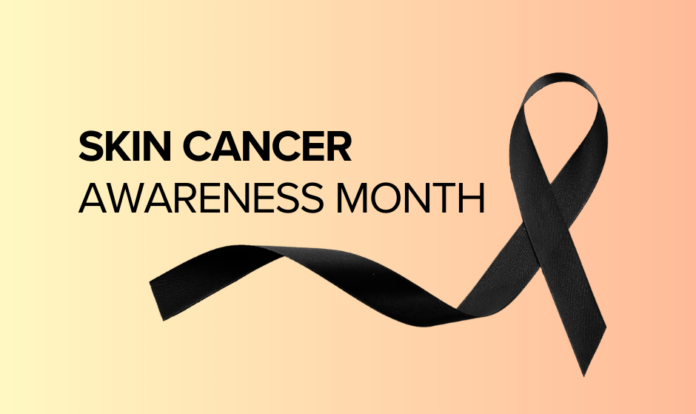For decades, May has been dedicated to raising skin cancer awareness, and since 1995, the American Academy of Dermatology (AAD) has kicked things off with Melanoma Monday on the first Monday of the month.1
A third of all diagnosed cancer cases are skin cancers, and statistics from the Skin Cancer Foundation show that one in five Americans will develop it in their lifetime.2 Skin cancer can affect anyone and with summer around the corner, it’s important to understand the risks of developing skin cancer and how to protect yourself.
Types of skin cancer
Non-melanoma skin cancers include basal cell carcinoma (BCC) and squamous cell carcinoma (SCC).2 These types are rarely fatal if caught early, but the surgical treatment needed to remove them can be painful and disfiguring. Non-melanoma cancers are most common on sun-exposed areas of the body like the ears, face, neck, and forearms, where long-term UV exposure is a major causal influence.
Malignant melanoma is less common than non-melanoma skin cancers, but it is the most deadly form of skin cancer.2 This unpredictable cancer can appear suddenly or develop from a mole. It can strike anywhere, but it occurs most often on the upper back, torso, legs, head, and neck. Since it can spread quickly, early detection through skin checks is crucial.
What you need to know
Skin cancer rates are climbing at an alarming pace. Each year, an estimated 2-3 million cases of non-melanoma and 132,000 cases of melanoma are diagnosed worldwide.3 In the U.S. alone, a staggering 9,500 people receive a skin cancer diagnosis every single day.
What are the underlying risk factors?
- History: having a personal or family history of skin cancer.
- Sun: excess exposure to UV radiation from sunlight.
- Tanning beds: use of tanning beds increases melanoma risk, but females under 30 who use them are six times more likely to develop melanoma.4
- Sunburns: five or more bad sunburns as a teenager increases the risk of melanoma by 80% and non-melanoma skin cancer by 68%.5
- Skin color: having fair or light-colored skin increases skin cancer risk, because less melanin (skin pigment) offers less natural sun protection.
- Hair and eye color: blonde or red hair and blue, green, or gray eyes increases risk, as these traits also indicate lower melanin levels.6
- Skin type: having skin that burns easily, or over 50 moles (atypically shaped or large).
- Immune health: a weakened immune system i.e., people with human immunodeficiency virus (HIV), or those taking immunosuppressant drugs after organ transplants.6
How can you reduce your risk?
- Don’t use indoor tanning beds.
- Use sunscreen regularly (broad-spectrum, water-resistant, SPF 30 or higher).7,8
- Wear skin-protective clothing (long-sleeved shirts, pants, wide-brimmed hats, and sunglasses).
- Regularly check your skin for signs of cancer.
- Minimize environmental toxins such as arsenic, coal, tar, chimney soot, paraffin, and tobacco.6
Symptoms to look out for
Skin cancer warning signs include the ABCDEs of melanoma:
- Asymmetry: Does a mole have uneven halves?
- Border: Is the border irregular or blurred?
- Color: Does the mole have multiple colors, or has a single color changed?
- Diameter: Is the mole larger than a pencil eraser (about 6mm)?
- Evolving: Has a mole changed in size, shape, or color?
If you spot any unusual changes, new growths, or persistent sores, don’t wait! Schedule an appointment with a board-certified dermatologist.
What can I do this March?
Give yourself a skin exam to check for any signs of skin cancer. See how to do a self-exam here.
Wear a black ribbon to symbolize your support for skin cancer awareness month.
Get involved with the National Council on Skin Cancer Prevention, or other organizations, to educate, advocate, and raise awareness for skin cancer.
Donate to a skin cancer charity to help with the cause:
- The Skin Cancer Foundation
- Canadian Skin Cancer Foundation
- Skin Cancer Foundation
- Melanoma Research Foundation
Spread awareness within your community. If you or someone you know has been affected by skin cancer, you can share your story with the AAD or SCF.
References
- May is Skin Cancer Awareness Month. www.aad.org. Accessed April 30, 2024. https://www.aad.org/public/public-health/awareness-campaigns/skin-cancer-awareness-month#:~:text=The%20AAD%20began%20Melanoma%20Monday
- World Health Organization. Radiation: Ultraviolet (UV) radiation and skin cancer. www.who.int. Published October 16, 2017. https://www.who.int/news-room/questions-and-answers/item/radiation-ultraviolet-(uv)-radiation-and-skin-cancer
- American Academy of Dermatology Association. Skin cancer. Aad.org. Published April 22, 2022. https://www.aad.org/media/stats-skin-cancer
- Lazovich D, Vogel RI, Weinstock MA, Nelson HH, Ahmed RL, Berwick M. Association between indoor tanning and melanoma in younger men and women. JAMA dermatology. 2016;152(3):268-275. doi:https://doi.org/10.1001/jamadermatol.2015.2938
- Wu S, Han J, Laden F, Qureshi AA. Long-term Ultraviolet Flux, Other Potential Risk Factors, and Skin Cancer Risk: A Cohort Study. Cancer Epidemiology and Prevention Biomarkers. 2014;23(6):1080-1089. doi:https://doi.org/10.1158/1055-9965.EPI-13-0821
- Risk factors for non-melanoma skin cancer. Canadian Cancer Society. https://cancer.ca/en/cancer-information/cancer-types/skin-non-melanoma/risks#ci_working_with_certain_products_47_1379_07
- Green AC, Williams GM, Logan V, Strutton GM. Reduced melanoma after regular sunscreen use: randomized trial follow-up. Journal of clinical oncology : official journal of the American Society of Clinical Oncology. 2011;29(3):257-263. doi:https://doi.org/10.1200/JCO.2010.28.7078
- Watts CG, Drummond M, Goumas C, et al. Sunscreen Use and Melanoma Risk Among Young Australian Adults. JAMA Dermatology. 2018;154(9):1001. doi:https://doi.org/10.1001/jamadermatol.2018.1774



